When Hygiene Meets Sustainability
September 12, 2022
There are many things that I have learned from working as a hospital volunteer. For one, hospitals are sterile spaces: spotless, dirtless, and bleached. Visitor protocols are strict, and the admissions desk abides by them almost robotically.
“Please wait in line.”
Take their temperature. Hand them a mask (if maskless).
“Please stay six feet away from others. Thank you.”
It’s a rhythmic routine, one born from caution, that extends throughout the hospital. Depending on the nature of the visit, some doctors may adorn a pair of nitrile gloves when they enter patient rooms. The sound, so rubbery, so sharp, goes something like this. Eee (the stretching of the gloves), psh (the putting on of the gloves), and thwack (the satisfactory tug and release of the gloves). And so, each day, it goes eee, psh, thwack. Eee, psh, thwack. For the rest of eternity.
Now, there is something that I forgot to add. And it goes like this: thud. The sound of a closing trash can. Thud. It’s so subtle that if you don’t listen for it, you might almost miss it. But that thud is the root of a major problem and one I intend to discuss.
Personal protective equipment (PPE) describes the various articles used to protect oneself from infectious material. Once used exclusively in medical settings, PPE is now an international household staple.
Since the start of the COVID-19 pandemic in March 2020, face masks have become essential. Gloves, once optional, are the new standards for food preparation and the beauty industry. These items protect us and the people around us from invisible dangers. Like the controlled environment of a hospital, they give us peace of mind with one wear and one toss. However, that peace of mind comes at the cost of the environment.
The model of single-use plastics focuses on the human craving for efficiency rather than on the long-term effects of all that waste. Gloves and medical gowns are mostly plastic. And masks, though partially cotton, are surrounded by a polypropylene layer that contributes to microplastics. From current research, we know that plastic probably won’t break down during our lifetime. It sits around in landfills, occasionally getting out into nature where it isn’t supposed to be. So, as the world cycles through all this PPE, which is usually also packaged with plastic, mountains of trash miles high are emerging. And, there’s nothing we can do about it except wait, maybe cover it with some dirt, and wait some more.
To give a true scale of how enormous this problem is, the British Dental Journal stated in an article that “if each individual in the UK wore a single-use face mask every day for one year, 66,000 tonnes of unrecyclable plastic waste would be generated.”
That statistic represents the UK alone, yet the unsustainable practice of single-use PPE is global. Unlike plastic bags, straws, or bottles, masks and gloves aren’t things we can just cut out of our lives. Born out of a necessity for sterility, they help us yet only hurt the planet. What, then, is the solution to this dilemma?
There are several ways to balance our sustainability with maintaining personal hygiene. One is the development of “eco-friendly” PPE. These include flower-seed masks and compostable gloves. Although these breakthroughs give us hope for the future, the technology is still improving and costs, as well as feasibility, won’t be legitimate until years later.
However, refining our individual habits can actually reduce environmental damage, the first of which is reusing whenever possible. Though most medical-grade masks are labeled as disposable, they can be reused if done properly.
An article by Joanne Chen from The New York Times offers advice on reusing masks. “Personally, to keep track, I have five masks on rotation and seven brown paper bags marked with the days of week, lined up on my windowsill,” wrote Chen. “I place my mask in the appropriately labeled bag between uses during the day and at the end of it. After a week has passed, I either take the mask out to wear or move it to an eighth bag marked ‘Ready to Use.’”
This method effectively allows masks to be worn several times on end. Plus, the virus cannot proliferate without a host, so trapping contaminated masks in bags effectively kills them.
It’s worth mentioning that cloth masks, the most environmentally friendly method, were used early in the pandemic when PPE was reserved for frontline workers. Since then, studies have shown that they do little to stop the highly contagious variants of COVID-19.
As for gloves, it’s best only to use them when necessary and reasonable. Do you really need to be wearing and changing out gloves every time you go grocery shopping or riding the metro? The answer is no. I cannot tell you the number of times I have witnessed gloved individuals reach onto public surfaces, pause, and bring that gloved hand to their face to scratch at an eye or rub at a nose.
“You can make that mistake with or without gloves on,” said Penn State’s Center for Infectious Disease Dynamics (CIDD). “In some cases, wearing gloves gives people a false sense of security, or a sense that they can safely touch things with reduced risk.”
In reality, washing your hands is the best form of protection against infectious agents.
Individual acts of sustainability can go a long way. As we all soldier through this pandemic, staying mindful of our needs versus our wants can ensure that we arrive at a greener Earth on the other side.
Photo courtesy of FLICKR.COM

